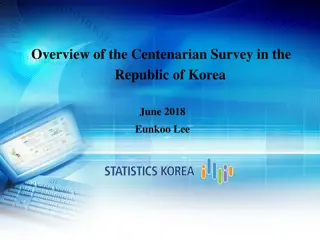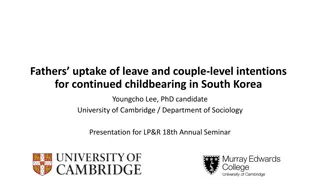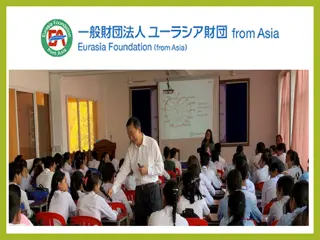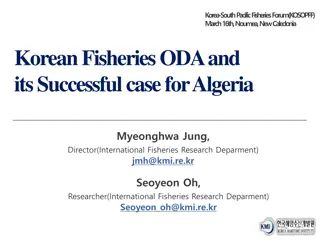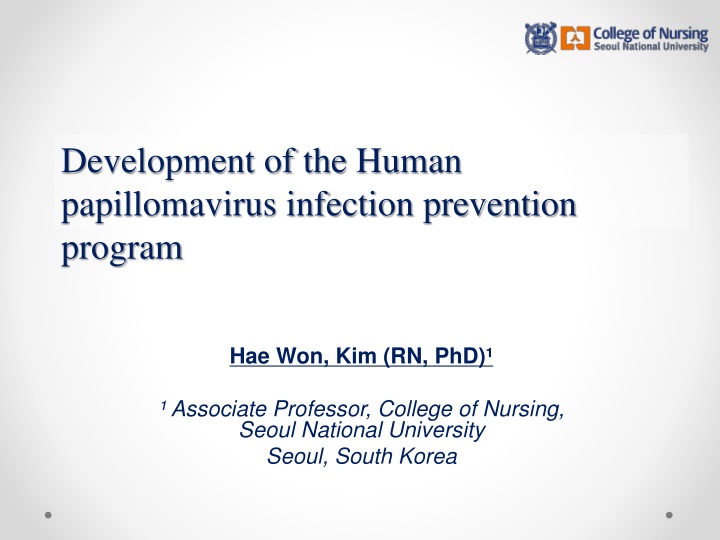
HPV Infection Prevention Program Development by Hae Won Kim
Explore the development of a human papillomavirus (HPV) infection prevention program by Hae Won Kim in South Korea, focusing on gender-based prevention efforts among Korean university students. Learn about the importance of HPV education for both men and women, the prevalence of HPV infection among sexually active men, gender differences in HPV knowledge and attitudes, and the significance of HPV vaccination to prevent new infections. Stay informed and involved in HPV prevention strategies.
Download Presentation

Please find below an Image/Link to download the presentation.
The content on the website is provided AS IS for your information and personal use only. It may not be sold, licensed, or shared on other websites without obtaining consent from the author. If you encounter any issues during the download, it is possible that the publisher has removed the file from their server.
You are allowed to download the files provided on this website for personal or commercial use, subject to the condition that they are used lawfully. All files are the property of their respective owners.
The content on the website is provided AS IS for your information and personal use only. It may not be sold, licensed, or shared on other websites without obtaining consent from the author.
E N D
Presentation Transcript
Development of the Human papillomavirus infection prevention program Hae Won, Kim (RN, PhD) Associate Professor, College of Nursing, Seoul National University Seoul, South Korea
Contents Effects of a Gender-Based HPV Prevention Program on Factors Related to HPV Prevention Among Male and Female Korean University Students Introduction 1 Background 2 Contents Methods 3 Results 4 Conclusions 5
Introduction HPV education The importance of including both men and women in HPV education and prevention efforts has been emphasized, within the context that they are equally responsible for HPV transmission (Wong 2009, Kim 2011)
Introduction HPV infection among sexually active men The incidence of cervical cancers has shown a decreasing trend, but the incidence of anal and oropharyngeal cancers has been increasing in the USA, and currently no public screening programs are applied for this (Gillison et al, 2008)
Introduction HPV infection among sexually active men The prevalence of anal HPV infection among sexually active men was 12.2 47.2%, with no age- group predilection. (Nyitray et al, 2011) The cumulative incidence of new infection of any genital HPV among the sexually active male university students was 62.4% over 24 months, which is higher than that reported for similar cohorts of young women. (Partridge et al, 2007)
Introduction Gender differences and Education Gender differences were reported for knowledge and attitudes related to HPV infection, and it was concluded that those differences should be managed via a tailored HPV educational program for university students. (Kim, 2011) HPV infection is rife among university students, regardless of their gender, and that it is critical to include men in any HPV-prevention
Introduction HPV vaccination The main focus of attempts to prevent HPV infection has been on HPV vaccination. According to a prospective study involving in multiple Western countries, men appear to have a stable risk for acquiring new HPV infection throughout their life; it was therefore suggested it would be cost effective to implement HPV vaccination to men worldwide. (Giuliano et al, 2011)
Introduction HPV vaccination The current HPV vaccination rate of young Korean women is very low, at less than 10%. (Kang & Moneyham 2010) We cannot rely solely on HPV vaccination to prevent the spread of HPV infection among both young men and women in Korea.
Introduction Aim of this study 1. To identify gender differences HPV knowledge Awareness of sexual rights Perception of gender equality Intention to prevent HPV
Introduction Aim of this study 2. To Examine the effects of a gender- based HPV- prevention educational program on these factors. Women -HPV knowledge -Awareness of sexual rights -Perception of gender equality -Intention to prevent HPV Men -HPV knowledge -Awareness of sexual rights -Perception of gender equality -Intention to prevent HPV Gender- based HPV- prevention Contents Title in here educational program
Background The contraction of HPV infection in males and their female partners is influenced by their sexual behaviors, and therefore an understanding of HPV infection itself in men is believed to be an essential component of HPV prevention. (Giuliano et al, 2011)
Background To be effective among university students, HPV prevention strategies should focus not only on HPV vaccination programs for girls and young women, but should also incorporate other measures for HPV prevention in the daily life, and should include men. (Kim, 2011)
Background Awareness of sexual rights and perception of gender equality are considered necessary in the gender-based approaches to STI prevention. (White et al. 2005, Kim et al. 2010) The uniqueness of the HPV-prevention educational program implemented in this study is basically linked to concepts of sexual rights and gender equality.
Background Sexual rights Sexual health will not be achieved or maintained without sexual rights for all humans. (World Association for Sexual Health 2008) Awareness of sexual rights was considered to be a starting point or fundamental content of the sexuality education should be prepared for responsible in themselves or interpersonal relationships. (Levesque 2000, Kim et al. 2010)
Background Gender equality Gender equality refers to the rights of men and women to nondiscrimination, and is considered a relational process. (Subrahmanian 2005) Gender inequality influences the sexual attitudes, practice, and health of both men and women, and therefore the issues of gender inequality should be reflected in the program contents in order to increase the effectiveness of sexuality education. (Rogow & Haberland 2005)
Background Theoretical framework Description of the contents Information-Motivation-Behavioral skills (IMB) model Information (Fisher & Fisher, 1992) Behavioral skills Behavior Change Description of the contents Description of the contents Motivation
Background Theoretical framework Applying the IMB model to the HPV prevention program in the present study. and sexual rights (HPV facts, specific prevention methods, awareness of sexual rights) to affect changes in HPV-prone or risky behaviors (awareness of sexual rights and perception of gender equality) in performing specific HPV-preventive behaviors, which could be measured via behavioral intentions as a proxy of the real behavior Information Behavior Change Description of the contents Motivation Behavioral skills
Background Hypotheses in this study Hypothesis Gender differences between university students will reduce with increasing knowledge of HPV, awareness of sexual rights and perception of gender equality, and intention to prevent HPV infection after completion of the gender-based HPV prevention educational program.
Background Hypotheses in this study Hypothesis Knowledge of HPV, awareness of sexual rights and perception of gender equality, and intention to prevent HPV will be enhanced in both male and female university students after they complete the gender-based HPV prevention educational program.
Methods Research design A quasi-experimental design Pretest Posttest Education Program 1st week 6th week 2nd~5th week Gender-based HPV prevention educational program Gender differences in factors Gender differences in factors 4-weeks, 12 sessions
Methods Sample 1. Via the school homepage and offline advertisements 2. September 27, 2010 ~ October 8, 2010 Sampling 1. Willingness to participate in this study. 2. Never having been married. 3. Not majoring in nursing, medicine, or public health. Inclusion criteria Exclusion criteria Had commenced or completed an HPV vaccination program
Methods Sample 62 Subjects was necessary : Sufficient Power 0.80, p<0.05, large effect size of 0.79(G power 3.12) + 20% missing subjects 66 Students Recruited 3 female students had been vaccinated for HPV, 2 male students were not able to attend the entire educational 2 female students did not attend the introductory session of the study 7 were excluded 59 Students Participated 31 men, 28 women
Methods Gender-based HPV prevention educational program Contents of the HPV prevention educational intervention Methodologies Session 1 Overview of the program and pretest Introduction among participants and the research team Session 2 Self introduction General HPV information: prevalence, pathology, types of HPV, HPV vaccines 1. Gender-specific HPV infection 2. Genital warts as a common STI among both genders Common specific approaches to prevent HPV for both genders Session 3 Lecture Session 4 Lecture Session 5 Lecture Session 6 Lecture Sexual autonomy and sexual rights for both genders Session 7 Discussion Sexism and prejudice regarding sexuality in Korean society Explore the experiences and feelings of gender inequality in their sexual health and interpersonal relationships Session 8 Discussion Session 9 Discussion&practice Sexually assertive communication skills, condom use Breaking prejudices about sexuality, STIs, and HPV Session 10 Discussion Summary of healthy behaviors to prevent HPV for both genders Session 11 Lecture Discussion&evaluati on Posttest and question-and-answer session Session 12
Methods Measures : Knowledge of HPV (5items) HPV can be asymptomatic HPV can disappear without treatment HPV vaccine prevents HPV infection Condoms prevent HPV HPV can affect men - A score of 1 was assigned to each item for a correct answer - A score of 0 was assigned for an incorrect or don t know answer - higher scores indicate better knowledge regarding HPV. - Cronbach s values of 0.88
Methods Measures : Awareness of sexual rights (17items) - 4-point scale ranging from 1 ( not at all important ) to 4 ( very important ) - The contents of the instrument included five factors related to sexual rights (sexuality education, free from prejudice and bias aberration, sexual satisfaction, safe and equal sexuality, and sexual autonomy) - Higher scores indicate a better understanding of sexual rights. - Cronbach s values of 0.80
Methods Measures : Perception of gender equality (5items) - The perception of gender equality was assessed by five items on the sexuality subscale of the Korean Gender Egalitarianism Scale (KGES) developed by the Korean Women s Development Institute (1999). - 5-point scale ranging from 1 ( very much agree ) to 5 ( never agree ) - higher scores indicated better perceptions of gender equality. - Cronbach s values of 0.72
Methods Measures : Intention to prevent HPV infection (6items) - 5-point scale ranging from 1 ( not at all ) to 5 ( very much ) 1. Intention to use a condom regularly 2. Intention to reduce the number of sexual partners 3. Intention to abstain from sex until marriage 4. Intention to be vaccinated for HPV 5. Intention to regularly undergo a Pap test or pelvic examination even before marriage (female students only), or intention to recommend a regular Pap test or pelvic examination to sexual partner (male students only 6. Intention to stop smoking (or to continue not smoking) - Cronbach s value of 0.80.
Methods Ethical considerations - The research protocol was approved by the University Hospital Institutional Review Board. - The participants were given specific information about the research program, and their right to stop their participation at any time. - The participants signed an informed consent form agreeing to their participation in this study, and they were assured that the data they provided would be confidential and anonymous. - The participants received the financial incentive.
Methods Data analysis - All variables were analyzed using frequencies, means, proportions, standard deviations, and percentages. - At the pretest, the homogeneity test of sociodemographic factors and the general HPV awareness between male and female students were analyzed using the t, 2, and Fisher s exact test - Gender differences in the measurement variables were analyzed using the Mann-Whitney U test.
Methods Data analysis At posttest - Gender differences in the measurement variables between groups were analyzed using the Wilcoxon signed-ranks test with Bonferroni correction. The effects of the HPV prevention program in each group were also analyzed using the Wilcoxon signed-ranks test. (version 18, SPSS, Chicago, IL, USA).
Results Gender comparisons of the subjects general characteristics Age N=59 21 20.57 19.7 19 Male Female 17 15 Male Female
Results Gender comparisons of the subjects general characteristics Grade N=59 3.2% 6.2% 14.3% 1 2 3 4 1 2 3 4 17.9% 32.2% 50% 58.1% 17.9% Male Female
Results Gender comparisons of the subjects general characteristics Living condition N=59 58.1 % 4% With parents 32.2 % 17.9% Alone, sublets Dormitory 6.2% 17.9% Male Female
Results Gender comparisons of the subjects general characteristics Sexual experience (Significant difference, p=0.023) N=56 15.4 Regular 20 3.8 Irregular 35.5% 80.8 None 50.% % 0 20 40 60 80 100 Female Male
Results Gender comparisons of the subjects general characteristics Number of sexual partners N: Male =13 Female=6 6 5 5.38 4 Male Female 3 2 1 1.33 0 Male Female
Results Gender comparisons of the subjects general characteristics STI examination Condom use N=52 N=50 9.1 0 Often 21.4 Yes 3.6 9.1 Raraly 25 100 No 81.8 Never 96.4 53.6 0 50 100 % % 0 50 100 Female Male Female Male
Results Gender comparisons of the subjects general characteristics Smoking experience N=59 Frequency of alcohol consumption N=59 17.9 2-3/week 7.1 25.8 Yes 61.3 17.9 1/week 25.8 42.9 1-2/month 92.9 45.2 No 38.7 21.4 Never 3.2 0 50 100 % % 0 10 Female 20 30 Male 40 50 Female Male (Significant difference, p<0.001)
Results Gender comparisons of the subjects general characteristics Heard of HPV Heard of genital warts N=59 N=59 14.3 10.7 Yes Yes 6.5 12.9 82.1 89.3 No No 93.5 87.1 0 50 100 % % 0 50 100 Female Male Female Male
Results Hypothesis Pretest 1.5 Knowledge of HPV 0.8 55.8 Awarehess of sexual rights 53.7 15.9 Perception of gender equality p= 0.016 13.8 4.5 p= 0.033 Regular condom use 4.0 4.6 Reduce number of sex partner 3.5 3.7 P< 0.001 P< 0.001 Abstinence from sex until marriage 2.5 3.7 Get HPV vaccination 3.5 4.8 Stop smoking or continue not smoking P=0.028 4.2 0.0 10.0 20.0 Male 30.0 40.0 50.0 60.0 Female
Results Hypothesis Posttset 2.8 Knowledge of HPV 2.7 Awarehess of sexual rights 58.6 17.6 Perception of gender equality p= 0.281 14.9 4.4 p= 0.266 Regular condom use 3.9 4.5 Reduce number of sex partner 4.0 4.0 P= 0.334 P= 0.180 Abstinence from sex until marriage 2.7 4.0 Get HPV vaccination 3.7 4.5 Stop smoking or continue not smoking P=0.440 4.1 0.0 10.0 20.0 Male 30.0 40.0 50.0 60.0 Female
Results Hypothesis These findings support the hypothesis that gender differences are reduced by improving knowledge of HPV, awareness of sexual rights and perception of gender equality, and intentions to prevent HPV infection among male and female university students as a result of completing a gender-based HPV prevention educational program.
Results Hypothesis Male 0.8 Knowledge of HPV p< 0.001 2.7 p= 0.005 53.7 Awarehess of sexual rights 58.6 13.8 p= 0.012 Perception of gender equality 14.9 4.0 Regular condom use 3.9 3.5 Reduce number of sex partner 4.0 2.5 Abstinence from sex until marriage 2.7 3.5 Get HPV vaccination 3.7 4.2 Stop smoking or continue not smoking 4.1 3.9 Recommend Pap test to partner P=0.013 4.4 0.0 10.0 Pre 20.0 Post 30.0 40.0 50.0 60.0
Results Hypothesis Female 1.5 Knowledge of HPV p= 0.002 2.8 p= 0.005 55.8 60.5 Awarehess of sexual rights 15.9 Perception of gender equality p= 0.033 17.6 4.5 Regular condom use 4.4 4.6 Reduce number of sex partner 4.5 3.7 Abstinence from sex until marriage 4.0 3.7 Get HPV vaccination 4.0 4.8 Stop smoking or continue not smoking 4.5 4.1 Regular undergo Pap test & Pelvic exam P=0.018 4.6 0.0 10.0 Pre 20.0 Post 30.0 40.0 50.0 60.0
Results Hypothesis The hypothesis that knowledge of HPV, awareness of sexual rights, and perception of gender equality, and intention to prevent HPV will be enhanced in both male and female university students after completion of a gender-based HPV prevention educational program was supported by our results.
Conclusions The gender-based approach was an effective educational program for both genders. Future strategies for HPV prevention should include men in HPV educational programs in order to reduce the spread of HPV.
Thank You! Acknowledgement: This research was supported by the Basic Science Research Program through the National Research Foundation of Korea (NRF), which is funded by the Ministry of Science, ICT & Future Planning (grant no. 2012-R1-A3015525). Add Your Company Slogan

















